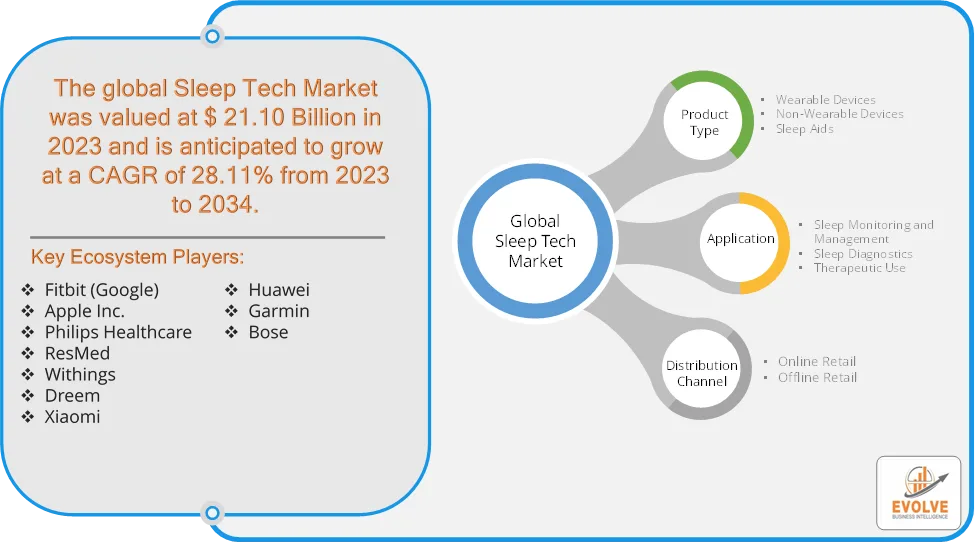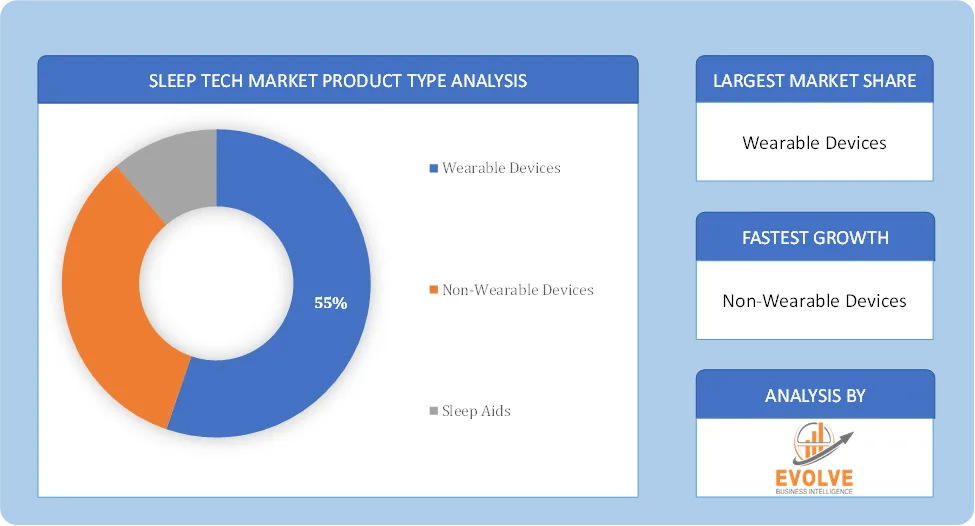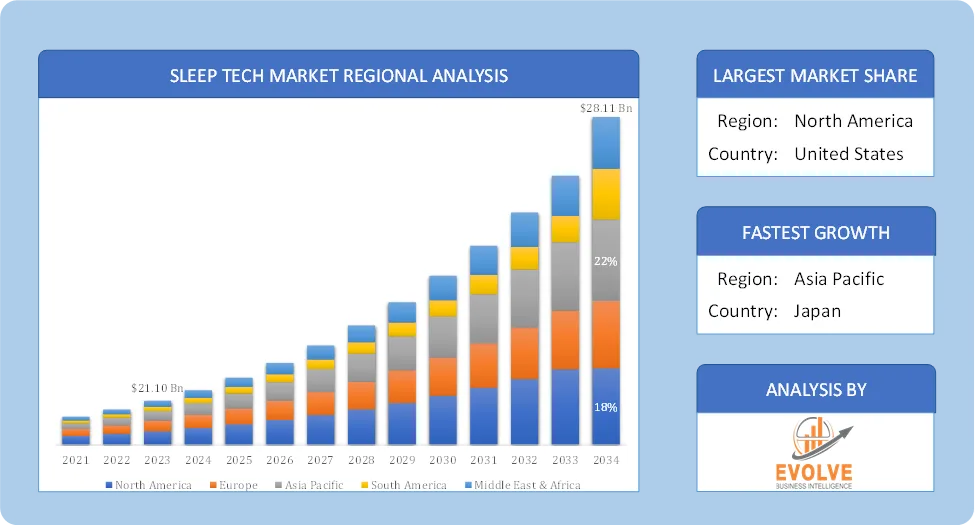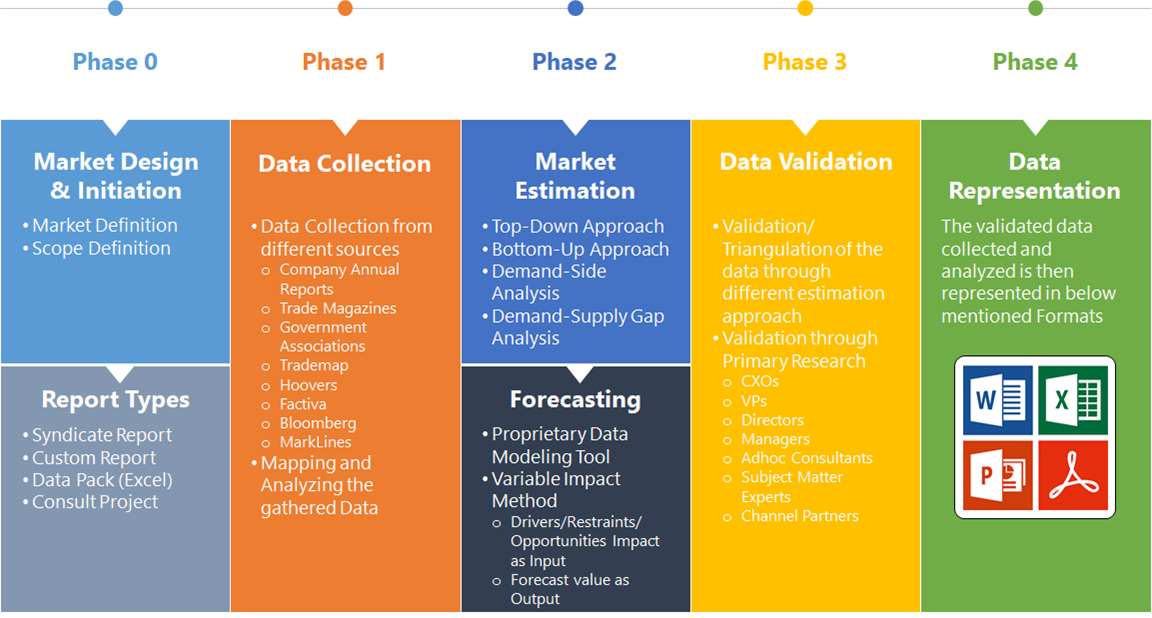CHAPTER 1. Executive Summary
CHAPTER 2. Scope of the Study
2.1. Market Definition
2.2. Market Scope & Segmentation
2.2.1. Objective of Report
CHAPTER 3. Evolve BI Methodology
3.1. Data Collection & Validation Approach
3.2. Market Size Estimation and Forecast
CHAPTER 4. Exclusive Analysis
4.1. Market Opportunity Score
4.1.1. Product Type Segement – Market Opportunity Score
4.1.2. Application Segment – Market Opportunity Score
4.1.3. Distribution Channel Segment – Market Opportunity Score
4.2. Key Market Influencing Indicators
CHAPTER 5. Market Insights and Trends
5.1. Value Chain Analysis
5.1.1. Raw Material
5.1.2. Manufacturing Process
5.1.3. Distribution Channel
5.1.4. End User
5.2. Porter’s Five Forces Analysis
5.2.1. Bargaining Power of Buyers
5.2.2. Bargaining Power of Suppliers
5.2.3. Threat of New Entrant
5.2.4. Threat of Substitute
5.2.5. Industry Rivalry
5.3. COVID-19 Impact and Post COVID Scenario on Sleep Tech Market
5.3.1. Impact of COVID-19
5.3.2. Government Support and Industry Revival Policies
5.3.3. Measures Taken by Companies to Mitigate Negative Impact
5.3.4. Post COVID Trend
CHAPTER 6. Market Dynamics
6.1. Introduction
6.2. Drivers
6.2.1. Driver 1
6.2.2. Driver 2
6.2.3. Driver 3
6.3. Restraints
6.3.1. Restraint 1
6.3.2. Restraint 2
6.4. Opportunity
6.4.1. Opportunity 1
CHAPTER 7. Sleep Tech Market, By Product Type
7.1. Introduction
7.1.1. Wearable Devices
7.1.2 Non-Wearable Devices
7.1.3 Sleep Aids
CHAPTER 8 Sleep Tech Market, By Application
8.1. Introduction
8.1.1. Sleep Monitoring and Management
8.1.2. Sleep Diagnostics
8.1.3. Therapeutic Use
CHAPTER 9. Sleep Tech Market, By Distribution Channel
9.1. Introduction
9.1.1. Online Retail
9.1.2. Offline Retail
CHAPTER 10. Sleep Tech Market, By Region
10.1. Introduction
10.2. NORTH AMERICA
10.2.1. North America: Market Size and Forecast, By Country, 2024 – 2034($ Million)
10.2.2. North America: Market Size and Forecast, By Product Type, 2024 – 2034($ Million)
10.2.3. North America: Market Size and Forecast, By Application, 2024 – 2034($ Million)
10.2.4. North America: Market Size and Forecast, By Distribution Channel, 2024 – 2034($ Million)
10.2.5. US
10.2.5.1. US: Market Size and Forecast, By Product Type, 2024 – 2034($ Million)
10.2.5.2. US: Market Size and Forecast, By Application, 2024 – 2034($ Million)
10.2.5.3. US: Market Size and Forecast, By Distribution Channel, 2024 – 2034($ Million)
10.2.6. CANADA
10.2.6.1. Canada: Market Size and Forecast, By Product Type, 2024 – 2034($ Million)
10.2.6.2. Canada: Market Size and Forecast, By Application, 2024 – 2034($ Million)
10.2.6.3. Canada: Market Size and Forecast, By Distribution Channel, 2024 – 2034($ Million)
10.2.7. MEXICO
10.2.7.1. Mexico: Market Size and Forecast, By Product Type, 2024 – 2034($ Million)
10.2.7.2. Mexico: Market Size and Forecast, By Application, 2024 – 2034($ Million)
10.2.7.3. Mexico: Market Size and Forecast, By Distribution Channel, 2024 – 2034($ Million)
10.3. Europe
10.3.1. Europe: Market Size and Forecast, By Country, 2024 – 2034($ Million)
10.3.2. Europe: Market Size and Forecast, By Product Type, 2024 – 2034($ Million)
10.3.3. Europe: Market Size and Forecast, By Application, 2024 – 2034($ Million)
10.3.4. Europe: Market Size and Forecast, By Distribution Channel, 2024 – 2034($ Million)
10.3.5. U.K.
10.3.5.1. U.K.: Market Size and Forecast, By Product Type, 2024 – 2034($ Million)
10.3.5.2. U.K.: Market Size and Forecast, By Application, 2024 – 2034($ Million)
10.3.5.3. U.K.: Market Size and Forecast, By Distribution Channel, 2024 – 2034($ Million)
10.3.6. GERMANY
10.3.6.1. Germany: Market Size and Forecast, By Product Type, 2024 – 2034($ Million)
10.3.6.2. Germany: Market Size and Forecast, By Application, 2024 – 2034($ Million)
10.3.6.3. Germany: Market Size and Forecast, By Distribution Channel, 2024 – 2034($ Million)
10.3.7. FRANCE
10.3.7.1. France: Market Size and Forecast, By Product Type, 2024 – 2034($ Million)
10.3.7.2. France: Market Size and Forecast, By Application, 2024 – 2034($ Million)
10.3.7.3. France: Market Size and Forecast, By Distribution Channel, 2024 – 2034($ Million)
10.3.8. ITALY
10.3.8.1. Italy: Market Size and Forecast, By Product Type, 2024 – 2034($ Million)
10.3.8.2. Italy: Market Size and Forecast, By Application, 2024 – 2034($ Million)
10.3.8.3. Italy: Market Size and Forecast, By Distribution Channel, 2024 – 2034($ Million)
10.3.9. SPAIN
10.3.9.1. Spain: Market Size and Forecast, By Product Type, 2024 – 2034($ Million)
10.3.9.2. Spain: Market Size and Forecast, By Application, 2024 – 2034($ Million)
10.3.9.3. Spain: Market Size and Forecast, By Distribution Channel, 2024 – 2034($ Million)
10.3.10. BENELUX
10.3.10.1. BeNeLux: Market Size and Forecast, By Product Type, 2024 – 2034($ Million)
10.3.10.2. BeNeLux: Market Size and Forecast, By Application, 2024 – 2034($ Million)
10.3.10.3. BeNeLux: Market Size and Forecast, By Distribution Channel, 2024 – 2034($ Million)
10.3.11. RUSSIA
10.3.11.1. Russia: Market Size and Forecast, By Product Type, 2024 – 2034($ Million)
10.3.11.2. Russia: Market Size and Forecast, By Application, 2024 – 2034($ Million)
10.3.11.3. Russia: Market Size and Forecast, By Distribution Channel, 2024 – 2034($ Million)
10.3.12. REST OF EUROPE
10.3.12.1. Rest of Europe: Market Size and Forecast, By Product Type, 2024 – 2034($ Million)
10.3.12.2. Rest of Europe: Market Size and Forecast, By Application, 2024 – 2034($ Million)
10.3.12.3. Rest of Europe: Market Size and Forecast, By Distribution Channel, 2024 – 2034($ Million)
10.4. Asia Pacific
10.4.1. Asia Pacific: Market Size and Forecast, By Country, 2024 – 2034($ Million)
10.4.2. Asia Pacific: Market Size and Forecast, By Product Type, 2024 – 2034($ Million)
10.4.3. Asia Pacific: Market Size and Forecast, By Application, 2024 – 2034($ Million)
10.4.4. Asia Pacific: Market Size and Forecast, By Distribution Channel, 2024 – 2034($ Million)
10.4.5. CHINA
10.4.5.1. China: Market Size and Forecast, By Product Type, 2024 – 2034($ Million)
10.4.5.2. China: Market Size and Forecast, By Application, 2024 – 2034($ Million)
10.4.5.3. China: Market Size and Forecast, By Distribution Channel, 2024 – 2034($ Million)
10.4.6. JAPAN
10.4.6.1. Japan: Market Size and Forecast, By Product Type, 2024 – 2034($ Million)
10.4.6.2. Japan: Market Size and Forecast, By Application, 2024 – 2034($ Million)
10.4.6.3. Japan: Market Size and Forecast, By Distribution Channel, 2024 – 2034($ Million)
10.4.7. INDIA
10.4.7.1. India: Market Size and Forecast, By Product Type, 2024 – 2034($ Million)
10.4.7.2. India: Market Size and Forecast, By Application, 2024 – 2034($ Million)
10.4.7.3. India: Market Size and Forecast, By Distribution Channel, 2024 – 2034($ Million)
10.4.8. SOUTH KOREA
10.4.8.1. South Korea: Market Size and Forecast, By Product Type, 2024 – 2034($ Million)
10.4.8.2. South Korea: Market Size and Forecast, By Application, 2024 – 2034($ Million)
10.4.8.3. South Korea: Market Size and Forecast, By Distribution Channel, 2024 – 2034($ Million)
10.4.9. THAILAND
10.4.9.1. Thailand: Market Size and Forecast, By Product Type, 2024 – 2034($ Million)
10.4.9.2. Thailand: Market Size and Forecast, By Application, 2024 – 2034($ Million)
10.4.9.3. Thailand: Market Size and Forecast, By Distribution Channel, 2024 – 2034($ Million)
10.4.10. INDONESIA
10.4.10.1. Indonesia: Market Size and Forecast, By Product Type, 2024 – 2034($ Million)
10.4.10.2. Indonesia: Market Size and Forecast, By Application, 2024 – 2034($ Million)
10.4.10.3. Indonesia: Market Size and Forecast, By Distribution Channel, 2024 – 2034($ Million)
10.4.11. MALAYSIA
10.4.11.1. Malaysia: Market Size and Forecast, By Product Type, 2024 – 2034($ Million)
10.4.11.2. Malaysia: Market Size and Forecast, By Application, 2024 – 2034($ Million)
10.4.11.3. Malaysia: Market Size and Forecast, By Distribution Channel, 2024 – 2034($ Million)
10.4.12. AUSTRALIA
10.4.12.1. Australia: Market Size and Forecast, By Product Type, 2024 – 2034($ Million)
10.4.12.2. Australia: Market Size and Forecast, By Application, 2024 – 2034($ Million)
10.4.12.3. Australia: Market Size and Forecast, By Distribution Channel, 2024 – 2034($ Million)
10.4.13. REST FO ASIA PACIFIC
10.4.13.1. Rest fo Asia Pacific: Market Size and Forecast, By Product Type, 2024 – 2034($ Million)
10.4.13.2. Rest fo Asia Pacific: Market Size and Forecast, By Application, 2024 – 2034($ Million)
10.4.13.3. Rest fo Asia Pacific: Market Size and Forecast, By Distribution Channel, 2024 – 2034($ Million)
10.5. South America
10.5.1. South America: Market Size and Forecast, By Country, 2024 – 2034($ Million)
10.5.2. South America: Market Size and Forecast, By Product Type, 2024 – 2034($ Million)
10.5.3. South America: Market Size and Forecast, By System, 2024 – 2034($ Million)
10.5.4. South America: Market Size and Forecast, By Distribution Channel, 2024 – 2034($ Million)
10.5.5. BRAZIL
10.5.5.1. Brazil: Market Size and Forecast, By Product Type, 2024 – 2034($ Million)
10.5.5.2. Brazil: Market Size and Forecast, By Application, 2024 – 2034($ Million)
10.5.5.3. Brazil: Market Size and Forecast, By Distribution Channel, 2024 – 2034($ Million)
10.5.6. ARGENTINA
10.5.6.1. Argentina: Market Size and Forecast, By Product Type, 2024 – 2034($ Million)
10.5.6.2. Argentina: Market Size and Forecast, By Application, 2024 – 2034($ Million)
10.5.6.3. Argentina: Market Size and Forecast, By Distribution Channel, 2024 – 2034($ Million)
10.5.7. REST OF SOUTH AMERICA
10.5.7.1. Rest of South America: Market Size and Forecast, By Product Type, 2024 – 2034($ Million)
10.5.7.2. Rest of South America: Market Size and Forecast, By Application, 2024 – 2034($ Million)
10.5.7.3. Rest of South America: Market Size and Forecast, By Distribution Channel, 2024 – 2034($ Million)
10.6. Middle East & Africa
10.6.1. Middle East & Africa: Market Size and Forecast, By Country, 2024 – 2034($ Million)
10.6.2. Middle East & Africa: Market Size and Forecast, By Product Type, 2024 – 2034($ Million)
10.6.3. Middle East & Africa: Market Size and Forecast, By Application, 2024 – 2034($ Million)
10.6.4. Middle East & Africa: Market Size and Forecast, By Distribution Channel, 2024 – 2034($ Million)
10.6.5. SAUDI ARABIA
10.6.5.1. Saudi Arabia: Market Size and Forecast, By Product Type, 2024 – 2034($ Million)
10.6.5.2. Saudi Arabia: Market Size and Forecast, By Application, 2024 – 2034($ Million)
10.6.5.3. Saudi Arabia: Market Size and Forecast, By Distribution Channel, 2024 – 2034($ Million)
10.6.6. UAE
10.6.6.1. UAE: Market Size and Forecast, By Product Type, 2024 – 2034($ Million)
10.6.6.2. UAE: Market Size and Forecast, By Application, 2024 – 2034($ Million)
10.6.6.3. UAE: Market Size and Forecast, By Distribution Channel, 2024 – 2034($ Million)
10.6.7. EGYPT
10.6.7.1. Egypt: Market Size and Forecast, By Product Type, 2024 – 2034($ Million)
10.6.7.2. Egypt: Market Size and Forecast, By Application, 2024 – 2034($ Million)
10.6.7.3. Egypt: Market Size and Forecast, By Distribution Channel, 2024 – 2034($ Million)
10.6.8. SOUTH AFRICA
10.6.8.1. South Africa: Market Size and Forecast, By Product Type, 2024 – 2034($ Million)
10.6.8.2. South Africa: Market Size and Forecast, By Application, 2024 – 2034($ Million)
10.6.8.3. South Africa: Market Size and Forecast, By Distribution Channel, 2024 – 2034($ Million)
10.6.9. REST OF MIDDLE EAST & AFRICA
10.6.9.1. Rest of Middle East & Africa: Market Size and Forecast, By Product Type, 2024 – 2034($ Million)
10.6.9.2. Rest of Middle East & Africa: Market Size and Forecast, By Application, 2024 – 2034($ Million)
10.6.9.3.Rest of Middle East & Africa: Market Size and Forecast, By Distribution Channel, 2024 – 2034($ Million)
CHAPTER 12. Competitive Landscape
12.1. Competitior Benchmarking 2023-
12.2. Market Share Analysis
12.3. Key Developments Analysis By Top 5 Companies
12.4. Market Share Acquisition Strategies: Analysis of Key Approaches Employed by Top Players
CHAPTER 13. Company Profiles
13.1. Fitbit (Google)
13.1.1. Hanon Systems
13.1.2. Financial Analysis
13.1.2.1. Business Segment Revenue, 2020, 2021, 2022, $ Million
13.1.2.2. Geographic Revenue Mix, 2022 (% Share)
13.1.3. Product Portfolio
13.1.4. Recent Development and Strategies Adopted
13.1.5. SWOT Analysis
13.2. Apple Inc.
13.3. Philips Healthcare
13.4. ResMed
13.5. Withings
13.6. Dreem
13.7. Xiaomi
13.8. Huawei
13.9 Garmin
13.10 Bose.








